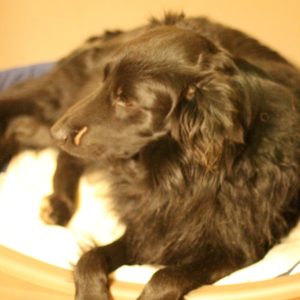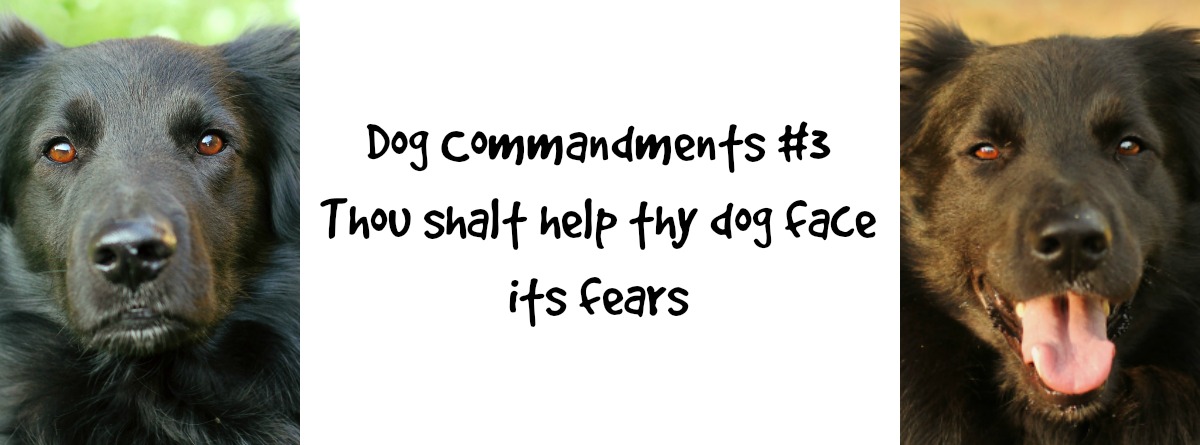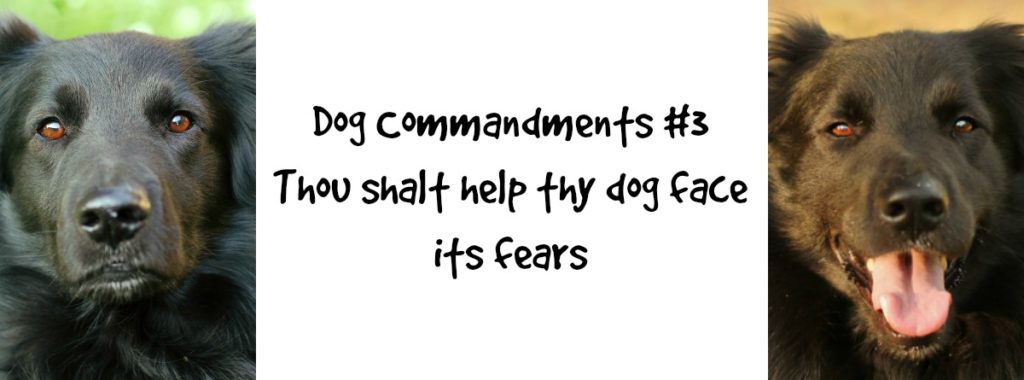Heston, like Mariah Carey, doesn’t do stairs. Stairs are not for him. At no point in my puppy training did I think to myself, “Hey, I live in a house without stairs… I must habituate Heston to stairs.”
It’s just not in the basic puppy training manual.
Imagine my surprise then, when spending a weekend dog sitting, finding Heston at two years old really, really reluctant to go upstairs. At first I thought it was because he was afraid of what was up there. It was in a house he’s really familiar with and he’d never been upstairs there. In the end, I carried him up. 65lb of dog and I carried him upstairs like Shaggy and Scooby Doo when Scooby gets all scared. He was so scared he peed all over me and I had to go back downstairs and mop up. He followed me down and luckily, he’d emptied his bladder for the return journey.
I thought nothing of it, but he did the same the second night. I never even made the connection with “upstairs” and “stairs.”
At a friend’s house last year, Heston made it upstairs in another friend’s house on his own, albeit with a little coaxing. Ah, how silly that was. I couldn’t get him down again. He absolutely would not set one foot on the stairs. No way. Not for love nor money. Yes, I carried my 65lb dog down the stairs. He peed on me again. That was fun.
As far as I know, Mariah Carey doesn’t pee on the stairs.
Heston is okay with steps. He’s okay with ditches. He’s okay with outside terrain that changes gradient. He’s okay with hopping up on to the bed, my couch, the car. I suspect it may be the narrowness of the stairs, the confines, the fact that French staircases are often marble tiled and spiral… I don’t know. He isn’t a very finely balanced dog. For instance, he is great at agility and jumps through hoops, over ditches, over jumps, but he doesn’t like jumping up and the old poodle dance thing is not for Heston either. Two legs bad.
The point is that it doesn’t really matter why, only what. Knowing this, I can do something about it, should I need to or want to. It’s not a matter of urgency, so it’s not up there on my priority list for habituation. You’ve got two questions to ask yourself:
How urgent is it that I address this fear?
How important is it that I address this fear?
For instance, it is neither urgent nor important. It’s more of a summer project for us than it is a vital, life-saving fear to face. By the way, on “things Heston is afraid of”, stairs are number 1. He has quite literally never “let go” quite so liberally with the old urine response in any other circumstance.
Yesterday, at the vets, it was clear that socialising him around other dogs and reducing his Tarzan-y ways has made a big difference. We got there to four dogs and two cats in reception and several humans. We stood away from the other dogs as there was an uncastrated Chow Chow who was “on guard” at the door. Significantly, Heston neither lunged for him nor gave off any aggression. That role was left to the Chow Chow. A huge St Bernard walked past and Heston and he had a friendly greeting without any aggression or over-excitement. I had to pull him back from a Dachshund and a poodle, both of whom were sitting on their owner’s knees… not something I’m a fan of for dogs since I’ve seen too many growl or aggress in this circumstance. Not sure if it’s the vantage point, the lack of security of a lap or protection detail, but it doesn’t happen when those little dogs are on the floor. But I was glad to see Heston choosing to take it easy with them and ignoring them for the main part.
I don’t know about Heston’s fears, but I fear going to the vets. The close confines, the number of dogs and unpredictable factors, the pain associations, the infrequency of the visits coupled with the importance of them. In the waiting room, they seemed to be much mitigated and Heston would sit, give a paw, give eye contact and behaved like any dog should. No barking, no growling, no over-exuberant attempts to play with every dog that doesn’t growl or bark. All that classical conditioning to make the vets a pleasant experience has definitely worked. I go to the vets at least once a week for various reasons, and I always take Heston with me, even if it’s just to pick up a bag of dog food. He always gets a treat and gets fussed by the staff. He likes seeing other dogs. He likes cats. Yes, classical conditioning has done its job.
Except for one thing.
When it came our turn to go into the exam room, Heston backed up and tried to get away. No way he wanted to go in there. What we say about generalising is so true. Just because he feels okay outside the vets and in the waiting room doesn’t mean that he feels okay in the exam room. Both he and Amigo are scared of the scales and they’re scared of the table. Let’s face it: it’s easy picking up a 25lb American cocker who is happy to be on the table and used to it (so she should be after the number of times we’re at the vet!) It is not easy picking up a scaredy 40lb griffon or a 65lb muttley. But my vet insists on table treatment for most exams (except Ralf – no way she wanted a 100lb dog up on her table with his badger-related injuries) and so I have to lift both up. Watching him, it’s clear he’s a bit nervous of the vet. But not overly. It wasn’t the vet who made him feel like this. Neither is it the injections. He didn’t even flinch for them. It could be any number of things: doors blowing open in the surgery, the chemicals, the smell… but his behaviour was definitely much more fearful around the scales and the table.
Heston isn’t a fan of being lifted. Lifting is what I do when we need to do a thing he’s scared of, like stairs. He’s also not a fan of that table.
Now I think about it, I can build in some specialist training on platforms and balance boards. I can also get him used to being picked up.
Urgent? Not so much, thankfully. Important? Very. I don’t want the first time I lift him onto a table to be the time the vet needs to examine his teeth or x-ray him. I don’t want lifting to be a cue for fear. Putting platforms and wobble boards into his training is only good sense, as is making the small movements to help him feel less uncomfortable being picked up.
Starting to do this from now on is crucial, so that I can factor in changes of environment, different types of table and different kinds of platform, as well as take time to help him with lifting. By this time next year, I hope that the table won’t freak Heston out.
For some dogs, a one-off event can be a real trigger point, and you can read a great insight into this from Dr Jen at Dr Jen’s Dog Blog
Once you’ve identified a fear that it is absolutely vital that your dog overcome, counter-conditioning and desensitisation are what you’re looking for. Basically, dogs learn in two ways: association and consequence. If I sit, then I get a biscuit. Consequence. If I jump on the lady, then she goes away. Consequence. If, then. What tiny bit of reasoning brain our dogs possess can learn that there are positive or negative consequences to things they do. Consequence is great for when your dog is in a calm, reflective state of mind.
Not so with association. One event can make a lifetime association. One thing can cause a lifetime of negative associations. Yet teaching by association can be painstaking and progress can be almost imperceptible.
Here’s something that caused a bit of consternation at my house.
Sometimes I close the gate from my courtyard into the main garden if I have puppies or dogs with no recall here on foster. I’m not chasing them down the garden or trying to get their attention over 100 metres. No thanks. If I want to leave Wobbly Bob the Mali out in the courtyard, I have to shut the gate too because he’s an expert hedge-hole finder and he likes to visit the neighbours. Usually, I open the gate when it goes dark because my dogs are up at the crack of dawn and they go out for a pee and I don’t. They like to go off down the garden for a morning stretch of the legs and I’m not a fan. 99 days out of 100, that gate is open. Thus, Amigo, Heston and Tobby barrel out of the house in the morning to a gallop or a canter. Last time I had a young dog here with zero recall, I shut the gate overnight. In the morning, despite the fact I’d left the light on so they could see, I heard a “gallop gallop woof woof smack hoooooooooow” from Heston and a little moment behind him, the same from Wobbly Bob. Four years of open gates and running out of the house at dawn evaporated.
He had a small wound – no vet required.

Heston wouldn’t go out of the door. It took two months for him to build up the confidence to go outside again in the dark in the morning. His physical wounds healed much more quickly than his psychological ones. In his mind, dark gardens in the morning = pain. Dark gardens at night before bed = safe. Gardens in daylight = safe. That association formed in one millisecond and took eight weeks to fade. He would quite literally not go out of the front door until we went for a walk at 9am, not even if his bladder was super-full, not even if he smelt an intruder or heard a bark (good thing we’ve got a home camera system and you can’t hear any outside barking from inside our house). Heston is fairly smart and fairly secure. He learned once again that it was pretty good fun to run out of the garden into the darkness beyond. One experience and a small wound and it takes weeks for a reactive dog to overcome that experience. With fearful dogs, that can take a lot longer. Wobbly Tobby, by the way, who had a similar wound, is obviously not such a giant baby and didn’t make that association between dark gardens and pain.
For fearful dogs though, one association can make a lifetime of fear. Couple that with the fact that when the sympathetic nervous system kicks in under “fight-or-flight” mode.
To a dog this means one thing: you’re on high alert. Their heart rate is faster. They’re producing adrenaline. Your dog’s pupils dilate so that their sight is heightened. Their ears may prick up. Their breathing is faster, shallower and jagged. Hackles may rise as their skin cells constrict. They may lose control of their bladder. Their saliva secretions change. Instead of watery saliva to aid digestion and the swallowing of food, saliva is thick and viscous to aid respiration. Blood moves from the digestive system to the muscles and lungs to prepare them to fight or to run away.
If you want your dog to “reason”, to think “action and consequence”, when they are afraid is precisely the time when they physically cannot listen to you. You could be waving a leg of lamb at them and it wouldn’t make the blindest bit of notice. This is why toys, food and affection can fail with fearful dogs. If they are on edge, they are not interested in food; they are not interested in playing. Their body thinks they are under threat and that is the only thing that matters to them. The brain is telling them that they are NOT eating (which is why many stressed animals won’t eat) and is producing the thick dribbly saliva to help them breathe effectively. Fido definitely doesn’t want a treat when he’s in fight-or-flight mode.
For many people who say their dog is not food-motivated, they may not have understood this stress response, or any of the other reasons food might not be working other than your dog is already full or isn’t used to working for food.
- The food is too low-value or the dog doesn’t like that food. It’s simply not worth working for.
- The environment is too stimulating: either it is too interesting or too arousing.
- The environment is scary and the dog is in fight-or-flight mode.
- The dog is over-excited (with a very similar chemical pathway for arousal as for fear)
- The dog is sick or in pain.
- The dog doesn’t understand what is being asked because too much is being asked at that point in time.
So how can you use positive methods to build in associations to counteract those that exist when we know stress changes appetites? How can you take a dog who won’t go out into the dark because they are scared and teach them that the dark is nothing to be afraid of, and neither is the gate?
The first step is to take them back to a safe space. A place and point where they feel relaxed. It should be a place that is neither stimulating or fear-provoking. A place where their reasoning brain will let the idea of consequence kick in again, and you can get a sit, a paw, eye contact. Their pupils are normal, their saliva is normal, their heart-rate is normal. Once the dog is in their safe zone, your aim is to gradually move them beyond. Since in their safe zone, they’ll accept treats, play or affection, you can use this as a reward for moving beyond. It is not a lure.
This great blog from Dogz and their Peoplez has a great video with a fearful beagle. You’ll see that the food is not a lure but a reward. The dog offers a behaviour and the trainer rewards it. She takes her dog back below the fear threshold and takes very, very gradual steps to make new connections so that where fear recedes, pleasure increases. This method is the same method used with people with phobias and is called desensitisation. It helps dogs become habituated to things that they feel afraid of. This is exactly what is happening in the video on Tracy’s blog. You’ll see also that she makes the journey in small stages, gradually expanding that safety zone and never asking too much.
When a dog feels comfortable, if it is hungry, it will eat. If the treats are high-value to the dog, you’ve got even more chance of success. If your dog is an over-stimulated monster, using those safe zones to teach calming and focus will mean that it is easier to foster these skills beyond the safe zone. A healthy dog who feels safe in his environment, who values the food you are offering and who is asked only to make small steps of progress in increments he can achieve is a dog who can be helped to overcome their fears with food.
By helping your dog face their fears or make positive associations with previously fearful experiences, you will have a dog who is more robust and resilient. Instead of letting fears reach epic proportions, careful re-education can allow your dog to switch his big brain on instead of wondering where to run away or whether he should put on a shouty bark festival. Whether it’s dark gardens, stairs or vets’ exam tables, fear is not something that your dog has to live with. It’s your duty as an owner to make sure your dog has the skills to cope and that you deal with those urgent or important fears in a positive and reinforcing way.


